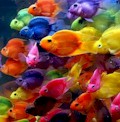An aquarium can range from a small glass bowl containing less than a liter (34.5 oz.) of water to immense public aquaria, which can house entire ecosystems such as kelp forest. Larger aquaria are typically recommended to hobbyist due to their resistance to rapid fluctuations of temperature and pH, allowing for greater system stability.
Aquarium ComponentsThe typical hobbyist aquarium includes a filtration system, an artificial lighting system, and a heater or chiller depending on the inhabitants of the aquarium. Many aquaria incorporate a hood, which prevents evaporation and protects fish from leaving the aquarium (or anything else entering the aquarium). They also often hold lights. Hoods can be opened and closed for access into the aquarium.
Combined biological and mechanical aquarium filtration systems are commonly uses. These are designed to either convert ammonia to nitrate or remove it or sometimes remove phosphate from water, removing nitrogen being at the expense of aquatic plants. Particulates incorporated into the filter can provide energy for microbes and sponges that do things like nitration. Filtration systems are often the most complex component of home aquaria and people use various design and combinations.
Aquarium heaters combine a heating element with a thermostat allowing and aquarist to regulate water temperature at a level above that of the surrounding air, whereas coolers and chillers are for use in cold-water aquaria, or anywhere the ambient room temperature is above the desired tank temperature. A variety of different thermometers are used, such as the glass alcohol thermometers, adhesive external plastic strip thermometers, and even battery powered LCD thermometers. In addition, some aquarists use air pumps attached to airstones or water pumps to increase water circulation and supply adequate gas exchange at the water surface. Wave making devices have also been constructed to provide wave action within the aquarium.
An aquarium’s physical characteristics form another aspect of aquarium design. Size, lighting conditions, density of floating and rooted plants, placement of bogwood, creation of caves or overhangs, type of substrates and other factors (including an aquarium’s positioning within a room) can all affect the behavior and survival of tank inhabitants. The combined function of these elements is to maintain appropriate water quality and characteristics suitable for the aquarium’s residents.
Aquarium MaintenanceIdeal aquarium ecology reproduces the balance found in nature in the closed system of an aquarium. In practice, all aquariums change, and aquarists are seldom satisfied with all aspects of their tank. As an example, a balanced predator-prey relationship is nearly impossible to maintain in even the largest of aquaria. Typically aquarium keepers must take steps to maintain balance in the small ecosystem contained in their aquariums.
Large volumes of water enable more stability in a tank by motivating aquarist to maintain them and by diluting effects from death or contamination. Any event that disrupts the system pushes an aquarium away from equilibrium, the more water that is contained in a tank the easier such as systemic shock is to absorb, as the effects of that event are diluted. For example, the death of the only fish in a three gallon (11 liter) tank causes dramatic changes in the system, while the death of that same fish in a 100 gallon (400 liter) tank with many other fish represents only a minor change in the tank balance. For this reason, hobbyist often favor larger tanks when possible, as they are a more stable system requiring less intensive attention to the maintenance of tank equilibrium.
There are a variety of nutrient cycles that are important in the aquarium. Dissolved oxygen enters the system at the surface water-air interface or through the action of an air pump. Carbon dioxide escapes the system into the air. The phosphate cycle is an important, although often overlooked, nutrient cycle. Sulfur, iron, and micronutrients also cycle through the system, entering as food and exiting as water. Appropriate handling of the nitrogen cycle, along with supplying an adequate balanced food supply, is enough to keep these other nutrient cycles in appropriate equilibrium but not forever.
